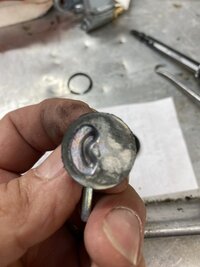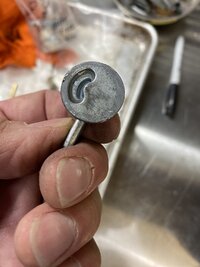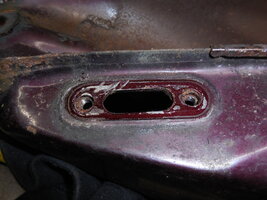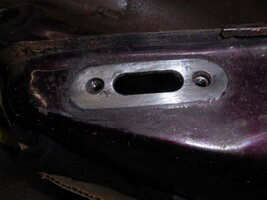...one more thing about petcocks on XS650s: there are at least two different types and they are NOT interchangeable - even though the fuel tanks among various XS650 years might be.
Early bikes (up to and including 1977 XS650D models) had petcocks that were not vacuum operated - and had <I think> a screw hole spacing of 38 mm. These are apparently still available at Partzilla.com and here is a linky to the site which shows them as available for the princely sum of about $128 USD - each.
The part numbers for these earlier petcocks is: 447-24510-02-00 and 447-24500-02-00 (there are left-hand and right-hand versions).
Later bikes used vacuum-operated petcocks (which, in my experience could be troublesome, but I know that many people have had no problems with them) and these units have a different mounting hole spacing of <I think> 42 mm. The two different types are NOT interchangeable because of the different hole spacing. While the Partzilla.com website shows that they are NOT available, here is a linky to the later model petcock.
The part numbers for the late model petcock are: 2FO-24500-01-00 and 2FO-24510-01-00 (again, left- and right-hand versions were made, and as you can readily see if you go to the website, the early and late model petcocks are quite different).
OK - so, I guess its time for my annual part number harangue.
Having the full OEM part number for a given part is absolute gold. If you walk into your Yamaha stealership and ask for a "petcock mounting screw for a 1978 XS650E", the parts dude's head will begin shaking as soon as he hears "1978". Your conversation will end with, "We don't carry no obsolete parts man!"
However, if you go in and ask him for a part number 90149-06008-00 screw, he will likely have a box full of them because that is a current Yamaha part number that is used on dozens of different Yamaha models - including bikes that they sell brand-new today - and has been for 45+ years and he'd be happy to sell you one of those for only about $5.28 USD as shown on the Partzilla website.
The other powerful thing about having that part number is that you can Google it - JUST the part number exactly as you see it above with no words or other descriptors - and you will find out who else has some for sale. I just did it now - and found dozens of people selling that exact screw for prices ranging from about $10 USD down to $2.22 Canadian (which is under $1.50 USD...at the current rate of exchange).
This works for just about any part of any vehicle (car, truck, boat, bike, etc.) or piece of machinery - and so you need to find a website that shows parts fiches (the exploded views of assemblies) along with the OEM part numbers - and grab those part numbers.
You will find that "standard" mechanical parts like screws, nuts and bolts, washers, seals, many ball and roller bearings etc. are not even unique to a given OEM. These standard parts are used by many manufacturers and so if you know the specifications of a given part, you can often find the identical item at another outlet or manufacturer for much less than a specialty shop such as a motorcycle dealership might charge.
Finally, there are two companies that build both cars and motorcycles - Honda and BMW. It turns out that they each use the same part number system for their bike and car divisions (and in Honda's case, their outboard motor, lawn mower, weedwhacker, and generator divisions too).
I used to ride a 2007 Honda ST1300 and the fairing was held together by a whole bunch of little plastic push-rivets. They cost $8-10 each at the bike shop - but the car dealership would sell you a package of 10 for about $12
at the bike shop - but the car dealership would sell you a package of 10 for about $12  - and when I Googled the part number, I found online retailers selling them for pennies each
- and when I Googled the part number, I found online retailers selling them for pennies each  .
.
Cheers, and happy parts hunting!
Pete
Early bikes (up to and including 1977 XS650D models) had petcocks that were not vacuum operated - and had <I think> a screw hole spacing of 38 mm. These are apparently still available at Partzilla.com and here is a linky to the site which shows them as available for the princely sum of about $128 USD - each.
The part numbers for these earlier petcocks is: 447-24510-02-00 and 447-24500-02-00 (there are left-hand and right-hand versions).
Later bikes used vacuum-operated petcocks (which, in my experience could be troublesome, but I know that many people have had no problems with them) and these units have a different mounting hole spacing of <I think> 42 mm. The two different types are NOT interchangeable because of the different hole spacing. While the Partzilla.com website shows that they are NOT available, here is a linky to the later model petcock.
The part numbers for the late model petcock are: 2FO-24500-01-00 and 2FO-24510-01-00 (again, left- and right-hand versions were made, and as you can readily see if you go to the website, the early and late model petcocks are quite different).
OK - so, I guess its time for my annual part number harangue.
Having the full OEM part number for a given part is absolute gold. If you walk into your Yamaha stealership and ask for a "petcock mounting screw for a 1978 XS650E", the parts dude's head will begin shaking as soon as he hears "1978". Your conversation will end with, "We don't carry no obsolete parts man!"
However, if you go in and ask him for a part number 90149-06008-00 screw, he will likely have a box full of them because that is a current Yamaha part number that is used on dozens of different Yamaha models - including bikes that they sell brand-new today - and has been for 45+ years and he'd be happy to sell you one of those for only about $5.28 USD as shown on the Partzilla website.
The other powerful thing about having that part number is that you can Google it - JUST the part number exactly as you see it above with no words or other descriptors - and you will find out who else has some for sale. I just did it now - and found dozens of people selling that exact screw for prices ranging from about $10 USD down to $2.22 Canadian (which is under $1.50 USD...at the current rate of exchange).
This works for just about any part of any vehicle (car, truck, boat, bike, etc.) or piece of machinery - and so you need to find a website that shows parts fiches (the exploded views of assemblies) along with the OEM part numbers - and grab those part numbers.
You will find that "standard" mechanical parts like screws, nuts and bolts, washers, seals, many ball and roller bearings etc. are not even unique to a given OEM. These standard parts are used by many manufacturers and so if you know the specifications of a given part, you can often find the identical item at another outlet or manufacturer for much less than a specialty shop such as a motorcycle dealership might charge.
Finally, there are two companies that build both cars and motorcycles - Honda and BMW. It turns out that they each use the same part number system for their bike and car divisions (and in Honda's case, their outboard motor, lawn mower, weedwhacker, and generator divisions too).
I used to ride a 2007 Honda ST1300 and the fairing was held together by a whole bunch of little plastic push-rivets. They cost $8-10 each
 at the bike shop - but the car dealership would sell you a package of 10 for about $12
at the bike shop - but the car dealership would sell you a package of 10 for about $12  - and when I Googled the part number, I found online retailers selling them for pennies each
- and when I Googled the part number, I found online retailers selling them for pennies each  .
.Cheers, and happy parts hunting!
Pete
Last edited:




